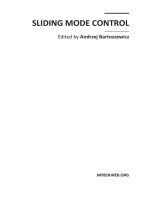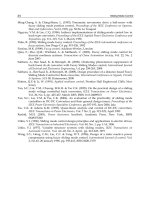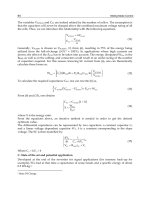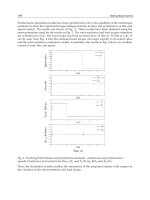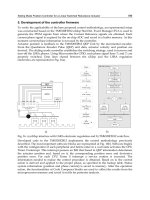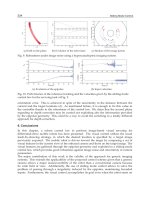Optimal path planning and adaptive sliding mode control of hexapod model
Bạn đang xem bản rút gọn của tài liệu. Xem và tải ngay bản đầy đủ của tài liệu tại đây (2.21 MB, 89 trang )
VIET NAM NATIONAL UNIVERSITY HO CHI MINH CITY
HO CHI MINH CITY UNIVERSITY OF TECHNOLOGY
---------------
LE HA ANH KHOA
OPTIMAL PATH PLANNING AND ADAPTIVE SLIDING MODE
CONTROL OF HEXAPOD MODEL
HO
NH QU
OT
U KHI
T
THÍCH NGHI MƠ HÌNH TAY MÁY SONG SONG HEXAPOD
MAJOR:
Control Engineering and Automation
MAJOR CODE: 8520216
MASTER THESIS
HO CHI MINH CITY, August 2021
THE RESEARCH IS COMPLETED AT:
HO CHI MINH CITY UNIVERSITY OF TECHNOLOGY VNU HCM
Instructor: Dr. Nguyen Vinh Hao
Examiner 1: Assoc. Prof. Dr. Nguyen Quoc Chi
Examiner 2: Assoc. Prof. Dr. Nguyen Tan Luy
The master thesis is defended at Ho Chi Minh city University of Technology
(HCMUT), VNU-HCM on Google Meet on August 19th, 2021.
Thesis Defense Council includes:
1.
2.
3.
4.
5.
Prof. Dr. Ho Pham Huy Anh
Dr. Pham Viet Cuong
Assoc. Prof. Dr. Nguyen Quoc Chi
Assoc. Prof. Dr. Nguyen Tan Luy
Assoc. Prof. Dr. Nguy n Minh Tâm
Chairman.
Secretary.
Reviewer 1.
Reviewer 2.
Member.
Verification
and the Dean of
faculty of Electrical & Electronics Engineering after the thesis being corrected (If any)
CHAIRMAN OF THE COUNCIL
DEAN OF FACULTY OF ELECTRICAL &
(Full name & signature)
ELECTRONICS ENGINEERING
(Full name & signature)
Prof. Dr. Ho Pham Huy Anh
i
VIET NAM NATIONAL UNIVERSITY
SOCIALIST REPUBLIC OF VIETNAM
HO CHI MINH CITY
Independence Freedom - Happiness
UNIVERSITY OF TECHNOLOGY
Full name: LE HA ANH KHOA
MSHV: 1870440
Date of birth: 24 02 1995
Place of birth: Ho Chi Minh City
Major: Control Engineering and Automation
Major code: 8520216
I. THESIS TOPIC: Optimal Path Planning and Adaptive Sliding Mode Control of
Hexapod model.
II. NHI M V VÀ N I DUNG: Design multi-objective optimal path planning based on
revolutionary swarm algorithm and then construct adaptive sliding mode control for
parallel manipulator Hexapod to track the optimized path.
III. TASKS STARTING DATE: February 24th, 2020
IV. TASKS ENDING DATE: June 13th, 2021
V. INSTRUCTOR: Dr. Nguyen Vinh Hao
Ho Chi Minh City, August 19th, 2021
INSTRUCTOR
HEAD OF DEPARTMENT
(Full name & signature)
(Full name & signature)
Dr. Nguyen Vinh Hao
Dr. Nguyen Vinh Hao
DEAN OF FACULTY OF
ELECTRICAL & ELECTRONICS ENGINEERING
(Full name & signature)
ii
THANK YOU
I would like to say thank you to my mom who helps and gives me special care from
the beginnings to endings.
Besides, I also give my honor to my professor, Dr. Nguyen Vinh Hao who inspires
and provides to me a lot of helpful advices and guidances for this project.
hich donated
motors and controllers for building up my mechanical model.
Thank you to the Delta Technical Support team who trained and instructed me
how to use their PLC and Servo system in this project.
Thank you to all my friends, my brothers, my colleagues who were beside and
encouraged me to pass those most difficult moments.
iii
ABSTRACT
Researchers often think about the spider robot when hearing the term Hexapod.
However, in this Master of Science thesis, we talk about a special manipulator which
has 6 degrees of freedom in motion invented by Dr. Stewart about a half-century ago.
Throughout the thesis, two problems that are examined are Multi-Objective
Optimal Path Planning Algorithms and Adaptive Sliding Mode Controllers designing
for the high complexity parallel manipulator with 6 degrees of freedom (6-DOFs) in
translation and orientation, the Rotary Parallel Manipulator Hexapod. The optimal
path planning algorithms are developed base on the formula of B-spline curves with
the objectives to a minimum the motion times & path lengths and while satisfying the
constraints of the Hexapod mechanical structures such as the limitation of active joint
angles, joint angular velocities, joint accelerations, and a maximum of the joint torque
outputs of the servo motors. The scheme of solving these objective functions and
constraints follows the theories of multi-objective optimization of Particle Swarm
Optimization (MOPSO). The optimal solutions are chosen base on the objective
weighting method from the distribution of the Pareto sets. Then Adaptive Sliding
Mode Controllers (ASMC) are constructed either to overcome the chattering
phenomenon of the conventional sliding mode control technic and precisely track the
end-effector of the mobile platform to the following optimal path planning process.
The Hexapod simulation model is exported from the mechanical CAD design
software (SOLIDWORK). All the mathematical models and algorithms are realized
using MATLAB/Simulink software with the help of SimScapes Libraries. A lot of
simulations have been conducted to proof of the optimal path planning and the
asymptotical convergence stability of the control system.
iv
TĨM T T LU
Các nhà nghiên c u
các rơ-bơ nh n nh n
c nh
ng
n thu t
m t
c bi t có th chuy
ng theo 6 b c t do khác n
Stewart vào kho ng gi a th k
Xuyên su t lu
u Khi
c phát minh b i ti
c.
hai n i dung s
u a Bi n
c kh o sát là Ho ch
t Thích Nghi
t và quay, c
Hexapod. Gi i thu t ho
c phát tri n d
nh t
khi v n th a mãn các ràng bu c v
servo. Trình t gi
ng
B
u khi
t Thích Nghi
ng
u ra
v a kh c
ng
ra.
c xu t b n t
MATLAB/Simulink v i s tr giúp c a b
và tính
c xây d
m cu i c a t m ph
(SOLIDWORK). T t c các mơ hình tốn và gi i thu
c ti
trong
u ra c a các
(MOPSO). Các k t qu
ng (chattering) v a
ot
ng
tr ng s theo phân b c a
Mơ hình mơ ph
ph
it
c l a ch n d
các b
bám theo qu
dài
c tiêu và các hàm ràng bu c tuân theo
i n c a Gi i thu t T
ph c tình tr
ph c t p cao
i h n góc quay c a các kh p, v n t c
góc c a các kh p, các gia t c t i kh p, và moment xo n c
t
oT i
u song song d ng tay quay
cong B-spline v i các m c tiêu c c ti u th i gian d ch chuy n và
c a gi i thu t
nh Qu
u song song
v i 6 b c t do (6-DOFs) bao g m c
lí thuy t t
u
c th c hi n trên ph n m m
n SimScapes. Nhi u thí nghi m mơ
ch ng minh cho tính t
nh ti m c n c a h th
ph n m m thi t k
u khi n.
a qu
nh
v
DECLARATION
The author confirms that all the contents used in this thesis are unique and are
completely quoted and cited.
Ho Chi Minh City, August 19th, 2021
(Full name & signature)
Le Ha Anh Khoa
vi
TABLE OF CONTENTS
............................................................................. i
THANK YOU ................................................................................................................................ii
ABSTRACT ................................................................................................................................. iii
TÓM T T LU
.............................................................................................. iv
DECLARATION ........................................................................................................................... v
TABLE OF CONTENTS ............................................................................................................. vi
LIST OF FIGURES .................................................................................................................... vii
LIST OF TABLES ..................................................................................................................... viii
LIST OF ABBREVIATIONS ...................................................................................................... ix
Chapter 1.
INTRODUCTION ............................................................................................... 1
1.1.
Hexapod and The Stewart Platform ................................................................................... 1
1.2.
Optimal Path Planning & Trajectory Planning algorithms ...................................... 1
1.3.
Adaptive control algorithms.................................................................................................. 2
1.4.
The objectives of the thesis .................................................................................................... 3
1.5.
Thesis organization ................................................................................................................... 4
Chapter 2.
2.1.
LITERATURE REVIEW .................................................................................... 5
Kinematic Analysis..................................................................................................................... 5
2.1.1.
Inverse Kinematic .............................................................................................................. 5
2.1.2.
Forward Kinematic............................................................................................................ 9
2.2.
Dynamic Analysis .................................................................................................................... 10
2.2.1.
Velocity And Acceleration Analysis ........................................................................ 10
2.2.2.
Dynamic Modelling ......................................................................................................... 14
Chapter 3.
MULTI-OBJECTIVE OPTIMAL PATH PLANNING SCHEME ................ 16
3.1.
WORKSPACE ANALYSIS ....................................................................................................... 16
3.2.
MULTI-OBJECTIVE OPTIMAL PATH PLANNING SCHEME .................................... 18
3.2.1.
Singularity free path generation process ............................................................ 18
3.2.2.
The path interpolation algorithm using B-spline curve ................................ 18
3.2.3.
The Multi-objective path planning using Particle Swarm Optimization 20
vii
Chapter 4.
ADAPTIVE SLIDING MODE CONTROLLER ............................................ 25
4.1.
Conventional Sliding Mode Controller ........................................................................... 25
4.2.
Adaptive Sliding Mode Controller .................................................................................... 26
Chapter 5.
SIMULATION AND RESULT ........................................................................ 32
5.1.
Multi-objective Optimal Path Planning Test Plan ..................................................... 33
5.2.
Adaptive Sliding Mode Control Test Plan ..................................................................... 38
5.3.
Result of simulation................................................................................................................ 42
5.3.1.
Result of Multi-objective Optimal Path planning .............................................. 42
5.3.2.
Result of Adaptive Sliding Mode control .............................................................. 47
5.3.3.
Discussion ........................................................................................................................... 67
Chapter 6.
CONCLUSION AND FUTURE WORK ......................................................... 68
6.1.
Achievement .............................................................................................................................. 68
6.2.
Limitation.................................................................................................................................... 68
6.3.
Future work ............................................................................................................................... 69
LIST OF PUBLICATIONS ....................................................................................................... 70
REFERENCES ............................................................................................................................ 71
viii
LIST OF FIGURES
Figure 2.1 Model Diagram of Hexapod .............................................................................................. 5
Figure 2.2. The vector loop closure of one active link ................................................................ 6
Figure 2.3. The coordinates of joints Ai & Bi ................................................................................... 8
Figure 2.4. The forward kinematic model using Simscape Simulink................................ 10
Figure 2.5. The 6-DOF body sensor is used for tracking position, velocity, and
acceleration of the end-effector of the mobile platform ........................................................ 10
Figure 3.1 The process of workspace analysis ........................................................................... 16
Figure 3.2 The result of the workspace analysis process in 3D View XYZ ..................... 17
Figure 3.3 The result of the workspace analysis process in 2D View XY ........................ 17
Figure 3.4 The Multi-objective optimal Path planning ........................................................... 22
Figure 4.1 The conventional sliding mode controller ............................................................. 26
Figure 4.2 Adaptive Sliding Mode Controller .............................................................................. 26
Figure 5.1. Hexapod CAD model designed on SOLIDWORK software .............................. 32
Figure 5.2. Optimal path planning test plan ................................................................................. 35
........................................................................... 35
............................ 36
-
ck ..................................................................... 36
............................................................ 37
......................................................... 37
.................................................................................. 38
Figure 5.9. Adaptive Sliding Mode Control Test Plans ............................................................ 38
........................................................................ 39
..................................................................... 40
................................................................................ 40
........................................................................ 41
..................................... 42
Figure 5.15. The Pareto distribution of the three objective function costs ................... 42
ix
Figure 5.16. The average best solution in the task space coordinate ............................... 43
Figure 5.17. The average best solution in the joint space coordinate .............................. 44
Figure 5.18. The average best solution in the joint space coordinate with constraint
checking........................................................................................................................................................ 45
Figure 5.19. The 3D view of the simulation model of the Initial pose .............................. 46
Figure 5.20. The 3D view of the simulation model of the Final pose................................ 46
Figure 5.21 Space view of the platform position and orientation in the disturbancefree test ......................................................................................................................................................... 47
Figure 5.22 Space view of the platform position and orientation in the disturbance
test .................................................................................................................................................................. 47
Figure 5.23. The sensitive response of the system with external disturbance (X-Y-Z axis)
.......................................................................................................................................................................... 48
- angles) ........................................................................................................................................................... 49
Figure 5.25. The joint-space coordinate response in the disturbance-free test .......... 50
Figure 5.26. The joint-space coordinate response in the disturbance test .................... 50
Figure 5.27. The performance of Servo 1 in the disturbance-free test ............................ 51
Figure 5.28. The performance of Servo 1 in the disturbance test ...................................... 51
............................ 52
Figure 5.30 Space view of the platform position and orientation with Mp = 2.2639 kg
.......................................................................................................................................................................... 54
Figure 5.31 Space view of the platform position and orientation with Mp =5*2.2639
kg ..................................................................................................................................................................... 54
Figure 5.32. The sensitive response of the system with the change of platform mass
(X-Y-Z axis) Mp = 2.2639 kg............................................................................................................. 55
Figure 5.33. The sensitive response of the system with the change of platform mass
- -
Mp = 2.2639 (kg) ................................................................................................. 56
Figure 5.34. The joint-space coordinate response in the Mp test ...................................... 57
x
Figure 5.35. The joint-space coordinate response in the 5Mp test ................................... 57
Figure 5.36. The performance of Servo 1 in the Mp test ........................................................ 58
Figure 5.37. The performance of Servo 1 in the 5Mp test ..................................................... 58
Figure 5.38. The comparison of the performance between SMC and ASMC in servo 1
.......................................................................................................................................................................... 60
Figure 5.39 Space view of the platform position and orientation with disturbance-free
.......................................................................................................................................................................... 61
Figure 5.40 Space view of the platform position and orientation with disturbance . 61
Figure 5.41. The sensitive response of the system with the disturbance-free (X-Y-Z
axis) ................................................................................................................................................................ 62
Figure 5.42. The sensitive response of the system with the disturbance-
- -
angles) ........................................................................................................................................................... 63
Figure 5.43. The joint-space coordinate response in the disturbance-free test .......... 64
Figure 5.44. The joint-space coordinate response in the disturbance test .................... 64
Figure 5.45. The performance of Servo 1 in the disturbance-free test ............................ 65
Figure 5.46. The performance of Servo 1 in the disturbance test ...................................... 65
xi
LIST OF TABLES
Table 5-1. Hexapod Model Parameter ............................................................................................ 33
Table 5-2. Parameter used for B-spline interpolation ............................................................ 34
Table 5-3. Parameters of MOPSO process..................................................................................... 34
Table 5-4. Simulation Data Of Adaptive Sliding Mode Controllers .................................... 39
Table 5-5. Task space error compare for Case 1 ........................................................................ 53
Table 5-6. Task space error compare for Case 2 ........................................................................ 59
Table 5-7. Task space error compare for Case 4 ........................................................................ 66
xii
LIST OF ABBREVIATIONS
Abbreviation
PD
MRAC
MOPSO
CAD
Description
Proportional - Derivative
Model Reference Adaptive Control
Multi Objective Particle Swarm Optimization
Computer Aided Design
1
Chapter 1. INTRODUCTION
1.1.
Hexapod and The Stewart Platform
In this thesis, the Hexapod is designed based on the new structure of the Stewart
Platform (SP), invented by Dr. Stewart in 1965 [1]. The Stewart manipulator consists
of top-plate and baseplate connected with the help of six variable-length
electromechanical actuators with spherical joints (Spherical
Prismatic
Spherical
SPS type) that are used for rotation and translation of the top-plate concerning the
base-plate. In this study, we modify the origin linear actuators mechanism by
changing the combination SPS type to Revolute Spherical Spherical (RSS) type and
replacing the current prismatic joints with the new revolute joints. The Hexapod
attracts many researchers in the current decade due to its precision, rigidity, and the
high force-to-load ratio [2]. The proper coordination of the actuator's angles enables
the top plate to follow the desired trajectory with high accuracy. Thus the six inputs
to the SP in terms of torque are calculated by the controller and provided by highspeed servo motors. The outputs of the Hexapod are the upper plate's translation and
angular positions (in the surge, sway, heave, roll, pitch and yaw) usually sensed by
highly precise sensors or vision systems.
1.2.
Optimal Path Planning & Trajectory Planning algorithms
Although parallel manipulators have strong stiffness and high payload, their
workspaces are limit and exit many singular zones, which are the points where the
platform becomes uncontrollable [3]. Therefore, to avoid singular poses in the
operations, we need to have a singularity-free path planning algorithm. Various
projects have been working on these issues. B. Dasgupta et al proposed an algorithm
by using via points and Divide and Conquer strategy in [4]. Hao Li et al presented a
method to calculate singularity-free task space using Quasi-singularity measures [5].
The paper of H. Abdellatif and B. Heimann used the visibility graph methodology and
two heuristic functions to plan singularity-free motions [6]. However, the goals of the
path planning process are not only to find singularity-free paths but also to seek ways
2
that let the Hexapod to moving as fast as possible while satisfying the constraints of
mechanical structure such as the limits in position, velocity, acceleration, and torque
output from actuators. B. Xie et al used Discrete mechanics to generate optimal
trajectories [7]. For this kind of multi-objective optimization path planning for the
complex parallel manipulators, C. Dong et all have been researched optimal
singularity-free trajectory planning based on B-spline curves and evolutionary
algorithms for docking systems in [8], [9]. The B-spline curves combined with
Evolutionary algorithms are useful for solving multi-objective optimization motion
planning because of their flexibility and easy implementation [10].
1.3.
Adaptive control algorithms
Last decades, many researchers have worked on sliding mode control and adaptive
control technics for the Stewart platform. C. C.Nguyen et al proposed an adaptive
control scheme for the Linear SP with the baseplate is above the mobile platform [11].
In [12] Amir Ghobakhloo et al presented an adaptive-robust tracking control design
for SP. A sliding mode tracking control of the SP was presented by Chin-I Huang in
[13]. S. Iqbal studied the Robust Sliding
Mode controller design with uncertain
dynamics in presence of nonlinearities [14]. In [15], E. Yime et al detailed the robust
adaptive control of the SP based on the task space dynamics equations. J. Velasco et
al took some experimental validations of a sliding mode control for the SP used in
aerospace inspection [16]. Sung-Hua Chen and Li-Chen Fu chose Output Feedback
Sliding Mode with a Nonlinear Observer-Based Forward Kinematics Solution to
reduce the computational load in solving forward kinematics solutions when
controlling for their SP [17]. Ramesh Kumar P. proposes the application of a new
algorithm for the position control of SP. In their research, the existing integral sliding
mode control law for systems with matched disturbances is modified by replacing the
discontinuous part with a continuous modified twisting control [18]. There are
various control approaches for the position control problem using sliding mode
theories in different perspectives. A sliding mode controller is a variable structure
3
control, which has been successfully implemented in many electromechanical
systems for improving their performance and achieving robustness against
disturbances [19].
In recent years, a new trend in position tracking control design for robot
manipulators in general and also for SP that combines adaptive and sliding mode
control is attracting more and more researchers. Ayca Gokhan Ak et al proposed a
Fuzzy Sliding Mode Controller with RBF Neural Network for Robotic Manipulator
Trajectory Tracking [20]. Wu Dongsu et al provided an adaptive sliding controller in
task space on the base of the linear Newton-Euler dynamic equation of motion
platform in a six-DOF flight simulator in [21]. Their method uses a nonlinear adaptive
controller to identifies constant uncertain parameters and sliding control to eliminate
the influences of the time-varying uncertain parameters and external disturbance.
Radial Basis Functions and fuzzy neural networks were proposed for adaptive and
fixed sliding mode control of robotic manipulators in [22], [23], [24], [25], [26], [27],
[28]. Generally, many adaptive sliding mode control designs based on the sliding
surface have been conducted for robot manipulators and SP with linear actuators.
However, there is a lack of studies on SP with rotary actuators that will be proposed
in the next sections. Some previous projects can be addressed such as [29], [30], and
[31].
1.4.
The objectives of the thesis
In this study, first, we propose a method to calculate the kinematics and dynamics
of the Hexapod model. Then from the result of kinematics models, a workspace
analysis process is conducted to find non-singularity zones and the limitations of
workspace for the path planning processes. Next, we propose optimal path and
trajectory generation schemes inspired by B-spline curves and an evolutionary
algorithm, the multi-objective Particle Swarm Optimization (MOPSO). An adaptive
sliding mode control is developed for tracking the optimal path planning. The
adaptive controller is based on the conventional sliding surface combined with a
4
proportional derivative (PD) controller whose gains are adjusted online to provide
high tracking precision with fast finite-time convergence, less chattering, fast
transient response, and high robustness.
1.5.
Thesis organization
The rest of this thesis is organized as follows. Chapter 2 reviews the kinematic and
dynamic models of the platform, respectively. Chapter 3 presents path and trajectory
planning with multi-objective optimization methods. Chapter 4 establishes the
adaptive sliding mode control using sliding surface combined with adaptive
proportional derivative gain compensation to get the smooth actuators torques on
the planned path. The adaptive laws of the gain compensations are designed to ensure
real-time adjustment. Many simulations and evaluations have been conducted in
Chapter 5 to prove the optimization results and the fast convergence velocity of
tracking errors and the robustness of the adaptive sliding controllers. The final
chapter 6 of this thesis will be a summary of the work done and conclusions. Some
additional works that can be done in the future are also explained.
5
Chapter 2. LITERATURE REVIEW
2.1.
Kinematic Analysis
2.1.1. Inverse Kinematic
The inverse kinematics functions are the relations between the positions and
orientations of the end-effector of the mobile platform and the lengths/angles of the
actuators which are the most important functions in motion planning and control of
parallel manipulators [32].
Let define the two coordinate frames: {P} for the end-effector which is attached to
the origin of the mobile platform and {O} for the center of the base platform which is
the body-fixed frame.
In this thesis, we solve the inverse kinematics by finding the functions which
describe the relation of the angles of 6 active links (the crank arms) and the
translation
angles as follows
and orientation
,
, and
which are selected as Euler
of the mobile platform
concerning the base platform:
(2-1)
Where
are the angles of active links in the joint-space,
are non-linear functions that describe the inverse
kinematics, and
is the general coordinator of the mobile platform in the task space.
Figure 2.1 Model Diagram of Hexapod
6
The inverse kinematics are constructed based on the vector loop closure equations
[33].
(2-2)
is the rotation matrix which transforms the frame {P} to base frame {O}
(2-3)
Where
and
. However, the Hexapod with the (RSS) type
contains an extra link per leg: crank arm spherical Joint rod arm spherical joint.
(2-4)
(2-5)
(2-6)
(2-7)
It is noted that some notations of those equations are as below:
is the length of the active link (the crank arm length).
is the rotation angle of the active link ith in the Ai frame
is the length of the vector
(the rod arm length).
is the unit vector along the rod arm length.
Figure 2.2. The vector loop closure of one active link
7
Through the tangent half-angle substitution, the quadratic formula:
(2-8)
(2-9)
The Eq.(2-8) can be solved using the G, E, and F method:
(2-10)
Solving the Eq.(2-10), we have:
(2-11)
Substitute Eq. (2-11) to Eq. (2-9), we get the angle of active joints:
(2-12)
Another way to find the angles of active joints is from Eq.(2-13) and Eq. (2-14) [31]:
(2-13)
(2-14)
Where:
(2-15)
(2-16)
(2-17)
(2-18)
(2-19)
(2-20)
(2-21)
8
B3
B4
A3
A2
A4
X
Xp
Y
Z
O
rbn
B2
P
Zp
A5
Yp
A1
rPn
B1
A6
B5
B6
Figure 2.3. The coordinates of joints Ai & Bi
for the odd legs (i = 1, 3, 5; j=1, 2, 3)
(2-22)
for the even legs (i = 2, 4, 6; j=1, 2, 3)
for the odd legs (i = 1, 3, 5; j=1, 2, 3)
(2-23)
for the even legs (i = 2,4,6; j=1, 2, 3)
Let:
(2-24)
Where:
(2-25)
Then the angle of each active link is as follows:
(2-26)
In Eq. (2-26), the condition to satisfy the inverse kinematic model will be:
(2-27)
9
Formula (2-27) will be used as constraints functions in checking singular poses of
the path planning process.
2.1.2. Forward Kinematic
In contrary with serial robots, the forward kinematic functions of parallel
manipulators are very hard to obtain mathematically. Instead, many studies have
been conducted using numerical computation efforts or machine learning to
approximate the end-effector positions and orientations from the given
lengths/angles of the actuators [17].
In this thesis, the planning and controlling problems are no need to use the forward
kinematic model. However, we still need it to evaluate the performance of the
controller.
The forward kinematic used in this thesis is derived from the Simscape Simulink
model imported from mechanical design CAD Solidwork. The test plan is showed in
the following Figure 2.4 which the inputs are the feedbacks of active link angles from
the real model and the output is the 6-DOF position of the mobile platform endeffector taken from the 6-DOF body sensor attached to the Base_ref and PL_ref port,
respectively, in Figure 2.5.
10
Figure 2.4. The forward kinematic model using Simscape Simulink
Figure 2.5. The 6-DOF body sensor is used for tracking position, velocity, and
acceleration of the end-effector of the mobile platform
2.2.
Dynamic Analysis
The inverse dynamic of the Hexapod is required to obtain the torques and forces
transmitted to the actuators, which also has a close relationship with the energy
consumed in the process of the path planning process.
2.2.1. Velocity And Acceleration Analysis
From the inverse kinematics section, the vector loop closure equation is started
with:
(2-28)
It is noted that vector
is now a virtual link represented by the equation below:
(2-29)
Then vector loop closure equations would be transformed as follows:
(2-30)
11
From the inverse kinematics section, the position of the active rotary link and
passive link:
(2-31)
Where:
(2-32)
Because the active rotary link
, can only rotate and
remains constant so its
differentiation does not create extra variables. The passive link
, can rotate and
translate. The position kinematics are solved through the unit vectors si multiplied by
the passive link length
. In the velocity kinematics, the differentiation of these
vectors means the translation velocity of the COM of the links, and the angular velocity
is unknown. Because the lower spherical joint which connects to the active link and
the upper joint could be moved in any direction, so we cannot make a relationship to
calculate one of these passive links unknowns without knowing the others:
(2-33)
It is noted that both vectors are needed to calculate the
vector but the angular
velocity of the active rotary link cannot be solved mathematically. Therefore, we can
only calculate the numerical differentiation of its vector by the change in the defining
angle
concerning time.
(2-34)
Where:
(2-35)
During the full range of motion of the Hexapod moving platform, each incremental
change in the end-effector has a matching incremental change in the actuator angles.
They are repeated in a loop from the desired start position to the desired end position

